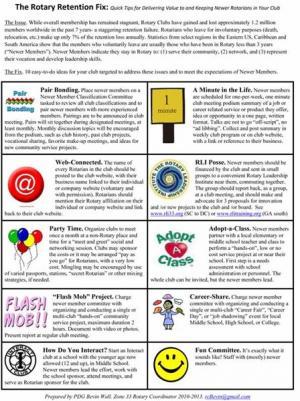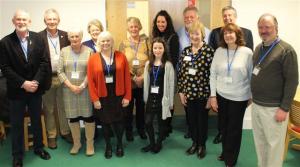Developing a Membership for the 21st Century
Developing a Membership for the 21st Century

13 Ideas For Membership Development
It is suggested that the Club Membership Chairman and Committee choose four of the following tips then organise the Club to complete one each quarter:
1. Proposal Card At a club meeting ask every member to fill out a Proposal Card. Follow-up by assigning individuals to invite the proposed individual to a club meeting or service project.
2. Friends of the Club President The Club President asks three members as a personal favour to propose a new member within a month. When the first one does so, approach another member in the same way so as to always have three members working on a personal pledge to the President.
3. Simultaneous Inductees Celebrate and induct several new members into the club simultaneously. Make it a really significant event.
4. Former MembersEncourage the Membership Committee to develop a list of former club members. Ask a current member to invite the former members to rejoin your club or encourage them to join the District eclub.
5. Community ProjectsA successful project attracts new members. Encourage all members to invite their friends to participate in a worthwhile community project.
6. Six-Month PlanEncourage every new member to bring in another new member within six months.
7. Five for One TeamDivide the Club into groups of five. Assign each group to bring in at least one new member within three months. Make this a contest with proper recognition for the winning group.
8. Rotary Guest DayDevelop a list of potential members and distribute invitations to those on the list. Host a meal and information evening for those who accept the invitation.
9. SurveyConduct a survey to help members consider contacts they know who might be potential members.
10. Club ForumHold an open club forum on membership development to discuss ways to seek out potential members. Follow up all the ideas.
11. Increase EffortsThink carefully about what might need to change to be more attractive to the new Rotarians. Venue, procedures or meeting times.
12. DiaryEncourage Club members to keep a 24 hour diary of everyone with whom they interact. Select potential members from that list and invite them along to a meeting.
13. Bring a Friend DayEncourage all members to bring guests to a club functions. Designate one meeting a month as Bring a Guest meeting.
+ Your Own IdeasWe recognize that there are many great ideas throughout the District. If you have one that could generate new members, Tim would be pleased to hear about it so it can be shared with other clubs in District 1100.
Is your club finding recruitment a challenge?
When you invite potential members along do they decide not to join? Have some members drifted away in the last few years? If your answer to any of these questions is 'yes' then perhaps it istime for a critical look at your cIub.
- Is it meeting the needs of the members?
- Do your members warmly welcome visitors?
- Is it attractive to busy professionals who may well make excellent Rotarians if only they could be
persuaded to join? - Has anyone asked them to join?
- Are the meetings interesting, lively, good use of time?
There is no good reason why your club can't change for the future.
Why not complete a 'Membership Satisfaction Questionnaire' which is part of the 'Club Assessments Tool'. (see link in Useful Material section)
If changes are needed why not discuss the possibilities in a positive constructive way with the aim of
regenerating the club so that it is more enjoyable, a better use of members' time and energy, more attractive to members and potential members.
Managing Change:
Of course some members will resist change because they like things the way they have always been; but is that a good enough reason for holding the club back? Many clubs have changed in recent years and are now enjoying new found growth as a result. They are happy, can achieve more and know that their club has a better future. Some members will hide behind rules and regulations to halt change.
Are these rules Rotary rules or are they just imagined?
RI have made it clear that they recognize that successful clubs are innovating. That's why they introduced the new pilot arrangement. About half the clubs that applied have been admitted to the pilot arrangements.
The good news:
The Rotary GB&I General Council in 2011 agreed that innovation should be encouraged and that clubs could ve inovative and run their clubs in different ways, subject to the agreement of the District Governor.
Similarly, with their DG's approval, clubs may form Satellite clubs or Innovate and be flexible in other ways in accordance with RI Guidelines. (see RI website)
If your club decides that these alternatives are suitable for you please contact the DG. Your District
Membership Officer, Tim Mason will be happy to help with the assessment or the change process if you wish, she is keen to help your club.
This is the guidance that Rotary GB&I received recently from RI:
In the most conservative sense clubs are not to engage in changes to the RI constitution or bylaws unless they have been accepted into a pilot program.
However, we also understand that clubs have employed corporate membership, associate membership, and are supporting satellite clubs outside of these pilots. We also know that clubs have employed a 'Friends of Rotary' status, similar to an associate membership category. Should clubs or districts decide to employ any of these changes outside of the pilot they would not be included in the results of the RI administered pilots. Note that we evaluate club activities on a number of criteria (retention trends, new members, contributions, projects, programs, etc) and we compare results of the pilot clubs to the results of a blind set of clubs.
One of the options under the satellite programme is to transfer smaller or weaker clubs into a satellite club
of a more active, established club. This is being considered in several instances. If a club is transferred into a satellite club they would be required to hand in their charter but there may come a point in time this club
could become operational on their own at a future point in time and therefore could regain their charter.
Note that there are many changes clubs can employ that do not require altering RI's constitution or bylaws such as changing a meeting time and day, altering club dues, changing meal expectations, etc. All clubs should be encouraged to assess their practices and if change is needed - then make the appropriate changes."
Change is always difficult to manage but you will find it will be worth it. Go on , give it a try. Lets have vibrant, innovative clubs throughout District 1100.
Related pages...

New Rotary Satellite Club - Rotary in the Rissingtons
more Have you thought of starting a satellite club in your area? If you have then here is a local example for inspiration.
back to page above this...
History File
back If you wish to view past information which is now out of date, please select appropriate pages(s)